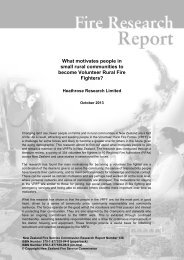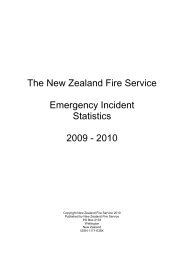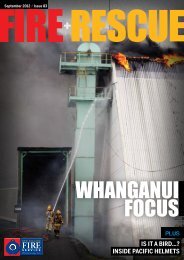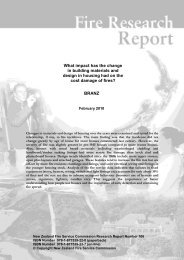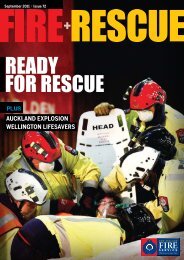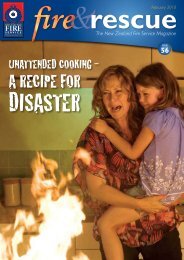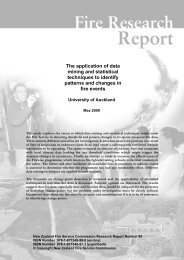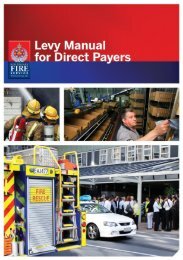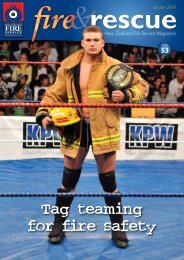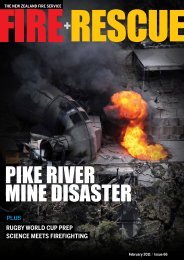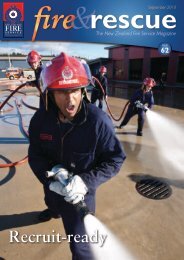Download PDF: Issue 27 - New Zealand Fire Service
Download PDF: Issue 27 - New Zealand Fire Service
Download PDF: Issue 27 - New Zealand Fire Service
Create successful ePaper yourself
Turn your PDF publications into a flip-book with our unique Google optimized e-Paper software.
January / February 2007<br />
The <strong>New</strong> <strong>Zealand</strong> <strong>Fire</strong> <strong>Service</strong> Magazine<br />
ISSUE<br />
<strong>27</strong><br />
In the<br />
Nick<br />
of time
January / February 07<br />
<strong>Issue</strong> No. <strong>27</strong><br />
<strong>Fire</strong> & Rescue is the flagship<br />
publication of the <strong>New</strong> <strong>Zealand</strong><br />
<strong>Fire</strong> <strong>Service</strong>.<br />
It is produced by Media,<br />
Promotions and Communications,<br />
National Headquarters,<br />
Level 9, 80 The Terrace, Wellington.<br />
Editor: Iain Butler<br />
Cover page: Rural firefighter Nick<br />
McCabe recuperating from burns<br />
suffered in Victoria.<br />
Story on page 4.<br />
Picture: Lance Lawson<br />
Back Cover: Blackened machinery<br />
covered in foam after a shed fire in<br />
Hawke’s Bay.<br />
Picture: John Cowpland<br />
We welcome contributions from<br />
<strong>Fire</strong> <strong>Service</strong> personnel and their families.<br />
Email stories and digital pictures to: fire.<br />
rescue@fire.org.nz<br />
(Pictures need to be at least 1MB)<br />
Post written material and celluloid<br />
photos, or photo CDs to:<br />
<strong>Fire</strong> & Rescue magazine,<br />
PO Box 2133, Wellington.<br />
(These will be returned on request)<br />
If you just have an idea or have an<br />
upcoming event you would like<br />
<strong>Fire</strong> & Rescue to cover, call<br />
Iain Butler on (04) 496 3675.<br />
<strong>Fire</strong> & Rescue is online at:<br />
www.fire.org.nz<br />
ISSN: 1176-6670<br />
All material in <strong>Fire</strong> & Rescue magazine is<br />
copyrighted and may not be reproduced<br />
without the permission of the editor.<br />
6<br />
8 10<br />
The issue Survival of the fittest ..........................................................................3<br />
Cover story Out of the black ...................................................................................4<br />
Good on ya, cobber .............................................................................6<br />
Incidents Waikato work-out ...............................................................................8<br />
Lolly to blame for horrific smash .............................................10<br />
Fried chicken sandwich ..................................................................11<br />
“We were three minutes from disaster”..............................11<br />
Ohope springs eternal ...................................................................12<br />
Trouble in paradise ..........................................................................13<br />
My Patch Boomtown station gets an upgrade ......................................14<br />
Obituary Life was a beach for Ken .............................................................16<br />
<strong>Service</strong> League of honourable gentlemen ...........................................17<br />
Pioneers get their due ....................................................................18<br />
<strong>27</strong>0 years of wisdom .....................................................................18<br />
Training If the capsize fits ..............................................................................19<br />
A great day for fires ........................................................................20<br />
... and a P lab or two .......................................................................20<br />
Staying afloat ......................................................................................21<br />
In the Community Wising up ..............................................................................................22<br />
Blanket security .................................................................................22<br />
Pilot still under control ....................................................................23<br />
Fun & Games No practise makes perfect .........................................................24<br />
Hair today, gone tomorrow .........................................................25<br />
Reverse psychology ..........................................................................25<br />
Perception .............................................................................................26<br />
Only kidding .........................................................................................26<br />
Noticeboard Notes and events .............................................................................<strong>27</strong><br />
14 16 21
An 18-year-old student died on his<br />
first night at a new flat after falling<br />
asleep while smoking in bed. A smoke<br />
alarm in the hallway had no battery,<br />
while one in the kitchen took too<br />
long to activate because it was<br />
incorrectly located.<br />
The death prompted Palmerston<br />
North mayor Heather Tanguay to<br />
call for a fitness certificate – similar<br />
to that given by councils to restaurants<br />
– for low-income rental properties,<br />
such as the hundreds in the city that<br />
cater to students.<br />
“It [the certificate] would be for<br />
things like that it had smoke alarms,<br />
doors that open and shut and<br />
windows that could be opened.”<br />
Heather says the issue was debated<br />
some years ago, but a change of<br />
council removed the will to go ahead<br />
with the scheme.<br />
She says the standard of some flats a<br />
few years ago left a lot to be desired,<br />
and is unsure how much has changed.<br />
“At the time I recall seeing properties<br />
with holes in the floors.”<br />
<strong>New</strong> <strong>Zealand</strong> Property Investors’<br />
Federation president Martin Evans<br />
says landlords don’t respond well to<br />
regulation, but agrees that putting<br />
the onus on tenants to make a flat<br />
safe won’t work.<br />
He says a subsidy on hardwired<br />
smoke alarms and other fire safety<br />
equipment could convince landlords<br />
short of available funds to improve<br />
the safety of their properties.<br />
“The most important thing to<br />
landlords is the safety of our tenants,<br />
who are our customers after all.”<br />
The issue<br />
Survival of the fittest<br />
A fatal fire in Palmerston North has rekindled debate<br />
about tenants’ rights and landlords’ obligations in low-income rental properties.<br />
Raetihi CFO John Compton at<br />
the scene of a rental property fire.<br />
The <strong>Fire</strong> <strong>Service</strong> is not convinced the<br />
scheme is workable. National safety<br />
integration manager Gary Talbot says<br />
local bodies are constrained by the<br />
Building Code, and cannot require<br />
property owners to do much beyond<br />
the rules set out there.<br />
“The Building Code says houses of<br />
a certain age need smoke alarms, but<br />
if the house is older than that, and<br />
hasn’t been renovated, there’s no law<br />
that can compel the owner to put in<br />
smoke alarms.”<br />
The <strong>New</strong> <strong>Zealand</strong> <strong>Fire</strong> <strong>Service</strong> Magazine January / February 2007 3<br />
Pictures: Ruapehu Bulletin, Ohope <strong>Fire</strong> Brigade
4<br />
Out of the black<br />
With a fireball bearing<br />
down on them, Nelson<br />
forestry contractor<br />
Nick McCabe and<br />
his team had a big<br />
decision to make –<br />
head for the unknown,<br />
or face the flames.<br />
<strong>Issue</strong> No. <strong>27</strong><br />
Cover story<br />
Nick was one of a dozen Kiwi<br />
firefighters injured when a fire ball<br />
rolled over them in Victoria late<br />
last year.<br />
Nick, Rotorua man John Tupara<br />
and Barrie Hunt from Canterbury<br />
suffered the worst injuries of 11<br />
“You can only make<br />
one decision – if you<br />
make two there’s<br />
confusion – so I made<br />
the call to get to the<br />
vehicles and run the<br />
gauntlet of the fireball.”<br />
firefighters caught in an unpredictable<br />
situation.<br />
The firefighters were part of a<br />
contingent of 47 <strong>New</strong> <strong>Zealand</strong>ers<br />
sent by the National Rural <strong>Fire</strong><br />
Authority to help contain wild<br />
fires in the mountainous north-east<br />
of Victoria.<br />
“We were at Mt Terrible to reinforce<br />
the containment lines around the city<br />
of Melbourne’s water catchment,”<br />
Nick says.<br />
It was an important job, ideally suited<br />
to Nick and others such as Northland’s<br />
Kevin Ihaka, who had only just<br />
returned from fighting mega wildfires<br />
in the United States, as well as having<br />
previous experience of bushfire<br />
seasons in Australia.<br />
On December 16, a week into their<br />
deployment, the team were tasked<br />
with containing a spot fire, a routine<br />
part of fighting wildfires of this scale.<br />
Internal Affairs Minister<br />
Rick Barker visits the front line.
There was no gung-ho approach to<br />
safety, and Nick says they spent about<br />
two hours assessing the fire and<br />
surrounding area and the best means<br />
of escape, before going in.<br />
“We had our LACES [bushfire safety<br />
steps] in place, and the beauty of it<br />
was we were going uphill [the safe<br />
side of the fire].<br />
Part way through their containment<br />
exercise, they were told there had<br />
been a ‘slop-over’, where fire had<br />
jumped the containment lines.<br />
The team retreated back to the<br />
slop-over point and set about<br />
extinguishing it.<br />
“There was no change to the wind<br />
direction and everything was going<br />
fine. I called up to Kevin [Ihaka] that<br />
it was pretty hot and we were going<br />
to have a spell.”<br />
While enjoying a short break,<br />
watching the spill over die out, the<br />
lookout called from the road that a<br />
fire was sighted and was moving<br />
towards them.<br />
“I could then see the flames, which<br />
looked more like a fireball than<br />
flames.”<br />
With the fire advancing on them, the<br />
group had two choices: go into the<br />
already burnt area on the slop-over<br />
(“the black”) or try to get clear of<br />
the bush altogether. Staying in the<br />
unburned bush around them was<br />
not an option.<br />
“Your training says go into the black,<br />
but the way it stood, if we went into<br />
the black it wouldn’t have been safe.<br />
“I’ve seen it before when in Australia<br />
in 2003; the fire burnt through the<br />
same area three times. It burns a<br />
different layer each time.”<br />
“You can only make one decision – if<br />
you make two there’s confusion – so I<br />
made the call to get to<br />
the vehicles and run the<br />
gauntlet of the fireball.”<br />
Some of the team,<br />
realising they would not<br />
have time to outrun the<br />
fireball, did what they<br />
were trained to do,<br />
sheltered in a ditch while<br />
the flames and hot gas<br />
burned over the top of<br />
them.<br />
Even now, Nick has no<br />
idea how long he was in<br />
the ditch.<br />
“We eventually got to<br />
the vehicles and I thought<br />
‘this bloody thing still<br />
might get us’.”<br />
In shock, Nick “didn’t<br />
do much” but sit in one of the<br />
vehicles, dousing himself in water.<br />
But something beside his burns was<br />
causing him distress.<br />
“My big concern was that we didn’t<br />
get everyone out. That was cutting<br />
me up.”<br />
Everyone was out, and all the other<br />
fears – that the fire would catch the<br />
escaping firefighters, or that<br />
helicopters wouldn’t be able to land<br />
for fear of bringing down a searing<br />
hot inversion layer of air over the<br />
wounded men – proved unfounded.<br />
Cover story<br />
Northland firefighters<br />
perform a haka.<br />
Nick is effusive in his praise for those<br />
who helped the crew, from the<br />
paramedics (one of whom cut off his<br />
shoulder patch and gave it to a<br />
stricken firefighter as a thank you),<br />
the Department of Sustainability and<br />
the Environment, <strong>Fire</strong> <strong>Service</strong> and<br />
Rural <strong>Fire</strong> staff who did all they could<br />
to reunite him with his family, to the<br />
hundreds of grateful Aussies, who<br />
sent letters and cards.<br />
“It was just about embarrassing,<br />
really. Just a simple card from Joe<br />
Farmer with a couple of hectares in<br />
the bush to say thanks, it really<br />
choked me up.”<br />
Nick McCabe is interviewed by TV3 days before he was burned.<br />
A month or so later, Nick’s right hand<br />
was still bandaged, his left peeling<br />
and pink, but the remnants of his<br />
injuries don’t mean much, because<br />
he’s still here to tell his story.<br />
Asked if the fire has changed his<br />
perspective on life, he only says,<br />
“It’s given me a bit to think about”.<br />
None of it has dampened his<br />
enthusiasm for firefighting, though.<br />
On the day his photo was taken,<br />
Nick said he would be back over<br />
the Tasman if he could.<br />
The <strong>New</strong> <strong>Zealand</strong> <strong>Fire</strong> <strong>Service</strong> Magazine<br />
January / February 2007<br />
Pictures: Lance Lawson, Alan Thompson<br />
5
Pictures: courtesy of Alan Thompson<br />
Good on ya,<br />
cobber<br />
It’s not everyone’s idea of a great <strong>New</strong> Year’s break, but there was<br />
no shortage of volunteers to take on some of the worst bushfires<br />
in Australia’s history.<br />
About 100 rural firefighters in<br />
two deployments were sent to<br />
Victoria to help with a fire season<br />
that got underway much earlier,<br />
and with much more ferocity, than<br />
in previous years.<br />
The first deployment included some<br />
firefighters who had barely got<br />
acquainted with the <strong>New</strong> <strong>Zealand</strong><br />
spring after a stint in the United States<br />
before they were answering the call<br />
of the three-country agreement and<br />
heading over the Tasman.<br />
6 <strong>Issue</strong> No. <strong>27</strong><br />
Cover story<br />
Victoria’s fires were no joke, burning<br />
through over a million hectares of<br />
land – an area the size of Jamaica.<br />
However, experienced rural fire<br />
manager Kevin Ihaka says it helps to<br />
see your own part in the fire, rather<br />
than worry about the bigger picture.<br />
“There was an incident management<br />
structure, breaking it down into<br />
sectors. When you’re just dealing<br />
with your line [of between three<br />
and 10 kms], it’s a lot more<br />
manageable.”<br />
Manageable,<br />
though, is a relative<br />
term. The fires were<br />
driven by conditions, and as a<br />
result, firefighters were at the mercy<br />
of wind changes.<br />
“It was just a hard slog all the way,<br />
with a lot of highs and lows. The<br />
highs were being able to leave your<br />
sector knowing it was under control,<br />
and on the other hand the lows were<br />
when we did a lot of work and the<br />
fire just did its own thing.”
Kevin says the crews worked hard to<br />
continue the reputation earned in the<br />
States of being thorough, skilful<br />
firefighters, and the locals were<br />
impressed.<br />
The pay-off wasn’t just in improving<br />
trans-Tasman relations, though.<br />
<strong>Fire</strong>fighters returning to <strong>New</strong> <strong>Zealand</strong><br />
– particularly the less experienced<br />
ones – have brought back a wealth<br />
of knowledge and experience,<br />
particularly in handling fire without<br />
water.<br />
“They’ve learned that water is not<br />
the be all and end all. There’s lots of<br />
techniques, like back-burning and<br />
hand-cutting fire breaks which we<br />
train in, but often don’t use. Now<br />
they’ve seen them working.”<br />
<strong>Fire</strong> conditions in Victoria appear to<br />
have eased for the time being,<br />
although other Australian states are<br />
now suffering, but it wouldn’t take<br />
much to convince many of the class<br />
of 2006/07 to return.<br />
Between Lake Eildon and the Dartmouth Reservoir in Victoria, Australia,<br />
dozens of active fires churned out thick clouds of smoke in early December.<br />
“The only thing stopping me is I<br />
would have to ask my family,”<br />
says Kevin. “I’ve been away three<br />
of the last six months.”<br />
Cover story<br />
Packing heat<br />
While about 100 people ended up<br />
crossing the Tasman to help out<br />
stretched firefighters, many more<br />
were queuing up to take their place.<br />
In Taradale and many other parts of<br />
the country, volunteer firefighters did<br />
their best to simulate the hot and<br />
heavy work across the ditch by<br />
hauling 40kg packs in a fickle <strong>New</strong><br />
<strong>Zealand</strong> summer.<br />
Ultimately, a third deployment of<br />
firefighters was not needed as<br />
conditions in Victoria eased, but these<br />
guys didn’t know that when they<br />
picked up their packs.<br />
The <strong>New</strong> <strong>Zealand</strong> <strong>Fire</strong> <strong>Service</strong> Magazine January / February 2007<br />
‘Packing heat’ pictures: Kerry Marshall<br />
7
Brigades in the Waikato have been hard at work with some<br />
of the most challenging, strenuous and stinky incidents in the country.<br />
Waikato work-out<br />
When a stock truck rolled in the<br />
middle of the year, there were a<br />
number of factors to consider: how<br />
to alleviate traffic, which had backed<br />
up in both directions around the<br />
crash scene; how to right the truck<br />
itself and rescue the bovine occupants;<br />
and how to overcome the awful<br />
stench from the inside of the truck.<br />
Cutting gear took care of the rescue<br />
mission, although sadly there were<br />
fatalities, but there was nothing to do<br />
about the god-awful stink.<br />
8 <strong>Issue</strong> No. <strong>27</strong><br />
Incidents
After slips claimed houses in the<br />
Wellington and Auckland regions, it<br />
was (nearly) Hamilton’s turn when<br />
two houses were left precariously<br />
close to the edge in Awatere Ave.<br />
As with houses in Lower Hutt<br />
and the North Shore which were<br />
left with a more dramatic view<br />
than was necessary, rain wasn’t<br />
the only culprit.<br />
Developers building apartments had<br />
removed vegetation and cut into the<br />
bank before the slip occurred.<br />
Once again, a good deal of ingenuity<br />
was called on, and contractors poured<br />
concrete and drove in several retaining<br />
posts to shore up the bank.<br />
Residents of one house were<br />
evacuated, but were able to return<br />
after one night away from home.<br />
In July, Paeroa firefighters had to<br />
carry out a tricky rescue and salvage<br />
mission when a huge tractor rolled<br />
into a canal.<br />
With the driver needing medical<br />
assistance, the first priority was<br />
stabilising the digger and getting into<br />
the cab.<br />
Incidents<br />
Pictures: courtesy of Roy Breeze<br />
A heavy-duty<br />
crane did the job<br />
of hauling the<br />
digger out of the<br />
water and up the<br />
bank.<br />
These pictures<br />
show how much<br />
damage was done<br />
to the cab.<br />
The <strong>New</strong> <strong>Zealand</strong> <strong>Fire</strong> <strong>Service</strong> Magazine January / February 2007<br />
9
Pictures: John Cowpland<br />
The hitherto unknown dangers<br />
of boiled sweets were on stark<br />
display in Central Hawke’s Bay<br />
recently when a milk tanker<br />
crashed through three houses.<br />
10 <strong>Issue</strong> No. <strong>27</strong><br />
Incidents<br />
Lolly to blame<br />
for horrific smash<br />
The driver, who was trying to give up smoking, was<br />
sucking a blackball while taking a tanker full of milk<br />
through the vicinity of Waipukurau when the lolly<br />
apparently lodged in his throat, causing him to black out<br />
and lose control of the truck.<br />
What happened next was both devastating and miraculous,<br />
as the truck drove through two houses before coming to<br />
rest in a third.<br />
No-one was killed and only one person hurt.
Fried chicken sandwich<br />
sections of a building caused Christchurch<br />
firefighters a headache in early January.<br />
The Tegal chicken factory in Hornby went up in flames<br />
on January 4, needing a response of about 60 firefighters<br />
to put it out.<br />
However, a “sandwich board” building technique, where<br />
a layer of polystyrene is sandwiched between sheets of<br />
metal, meant the fire was too dangerous to attack<br />
internally.<br />
Heat makes the polystyrene melt, meaning the walls can<br />
collapse easily and, if it catches fire, it becomes a flaming<br />
liquid which is difficult to extinguish.<br />
Entering a burning building made of this material is at<br />
best extremely unwise.<br />
The Tegal processing plant was destroyed in the fire,<br />
leading to call for such buildings to have sprinklers to<br />
prevent fires escalating. An electrical fault was thought to<br />
be to blame.<br />
“We were three minutes<br />
from disaster”<br />
When a petrol tanker with 7000 litres of fuel on board<br />
caught fire in the Southland tourist hub of Te Anau, it<br />
took a lot of cool heads to prevent a tragedy.<br />
CFO Graeme Humphries and the rest of the Te Anau<br />
volunteers arrived to find the tanker ablaze, with one tank<br />
on the verge of rupturing.<br />
Pictures: Barry Harcourt A building technique designed to insulate whole<br />
Incidents<br />
“We were three to five minutes away from disaster,” Graeme<br />
told The Southland Times. “My major concern was for<br />
the safety of my men and other people who were around.<br />
We got them as far away as possible in case it blew.”<br />
Having smothered the flames with foam, the crew spent<br />
two hours keeping the tanks cool with water.<br />
Ten houses were evacuated, with several residents doing<br />
the sensible thing as soon as they saw the fire and leaving<br />
their homes.<br />
The <strong>New</strong> <strong>Zealand</strong> <strong>Fire</strong> <strong>Service</strong> Magazine January / February 2007<br />
Picture: John McCombe<br />
11
Pictures: Ohope <strong>Fire</strong> Brigade, Whakatane Beacon/Geoff Mercer<br />
Ohope springs eternal<br />
12 <strong>Issue</strong> No. <strong>27</strong><br />
Incidents<br />
One fire managed to give Ohope’s<br />
volunteers a year’s worth of experience.<br />
The brigade in the town 10 kilometres east of Whakatane<br />
was called to a house fire on December 15, but got a bit<br />
more than it bargained for.<br />
Station officer Chris Staniland says the crew knew on<br />
arrival the solitary pump was going to be insufficient as<br />
the three-storey house was fully involved, with<br />
exposures threatening two near-by units and scrub.<br />
With a person reported to be inside the building, the<br />
brigade knew it had a ladder rescue on its hands as well,<br />
but that was just the start of the fun as the house fire<br />
got progressively more complex.<br />
Help was summoned from throughout the Western Bay<br />
of Plenty, with pumps from Whakatane eventually<br />
joining a Fonterra tanker from Egdecumbe, a rural<br />
tanker from the district council and a truck from<br />
Taneatua in pouring about 100,000 litres of water onto<br />
the fire. Edgecumbe brigade was put on stand-by at the<br />
Ohope station.<br />
As they began to attack the fire firefighters were told<br />
there were at least two 9 kilogram gas cylinders in the<br />
house. Soon after, local police warned there was<br />
ammunition there as well.<br />
A series of explosions heard during the fire were later<br />
traced to a burning acetylene cylinder.<br />
Then the house fire began spreading to bush, before<br />
jumping to a coastal reserve, consuming about 4<br />
hectares of vegetation.<br />
The cause of the fire may never be known, as fierce heat<br />
made any investigation impossible, beyond identifying<br />
where it had started.
Pictures: Graham Davies and courtesy of John Saunders<br />
We arrived in Tonga four days after<br />
the riots.<br />
It was very strange landing to find<br />
the airport surrounded by <strong>New</strong><br />
<strong>Zealand</strong> Defence personnel in full<br />
battle gear.<br />
The Nuku’alofa CBD was sealed<br />
off by checkpoints manned by<br />
Tongan troops. You needed a pass<br />
from the Prime Minister or had to<br />
be in uniform to get through the<br />
checkpoints.<br />
The centre of town was like a ghost<br />
town with no people on the streets –<br />
just police or Tongan troops. The<br />
exclusion zone covered an area about<br />
two km 2 , and in it there were dozens<br />
of damaged buildings, about 60 of<br />
which had been damaged by fire.<br />
Mike and I each led an arson<br />
investigation team of five, with a<br />
Tongan detective, and specialist<br />
search officer, investigator, and<br />
photographer / scene-of-crime officer<br />
Trouble in<br />
paradise<br />
from the <strong>New</strong> <strong>Zealand</strong> Police.<br />
We started work at 8 am each day<br />
and worked until about 4 pm at the<br />
fire scene, then worked on the reports<br />
until late in the evening.<br />
The fire-damaged buildings ranged<br />
from a single shop to a four-story<br />
hotel, a three-story office building, a<br />
shopping arcade, and a two-week-old<br />
twin cinema complex, and from a<br />
single building to a city block.<br />
At each scene the two fire safety<br />
officers would carry out a scene safety<br />
check, and report to the other<br />
members of the teams any safety<br />
issues before they entered the scene.<br />
Over the two weeks we completed 36<br />
fire investigations, with a report and<br />
five supplementary reports, resulting<br />
in the identification of 17 deliberate<br />
fires. The rest were exposure fires.<br />
This was a great experience, as most<br />
of the fire scenes were undisturbed;<br />
firefighting had taken place on only<br />
Incidents<br />
Transalpine fire safety officer Graham Davies<br />
reports from the aftermath of riots which swept<br />
through the Tongan capital Nuku’alofa in November,<br />
where he and Eastern Region FSO Mike Bull<br />
helped <strong>New</strong> <strong>Zealand</strong> and Tongan police investigate<br />
some of the arsons that accompanied the unrest.<br />
two buildings and the rest were left<br />
to burn themselves out.<br />
We met Minister of Police Annette<br />
King, Police Commissioner Howard<br />
Broad, the Chief <strong>Fire</strong> Officer of the<br />
Tongan <strong>Fire</strong> <strong>Service</strong> and lots of<br />
friendly Tongan people.<br />
By the end of the deployment we had<br />
seen most of the island of Tongatapu,<br />
and unfortunately caught whatever<br />
was in the water (or the chicken).<br />
The <strong>New</strong> <strong>Zealand</strong> <strong>Fire</strong> <strong>Service</strong> Magazine January / February 2007<br />
13
Boomtown<br />
station gets<br />
an upgrade<br />
By Debbie Jamieson<br />
14 <strong>Issue</strong> No. <strong>27</strong><br />
My Patch<br />
SO Roydon Cullimore with the<br />
fire station’s old call out method.<br />
As Queenstown goes through an<br />
unprecedented growth spurt, a $300,000<br />
station upgrade has ensured Queenstown’s<br />
Volunteer <strong>Fire</strong> Brigade can continue to meet<br />
the community’s needs.<br />
The resort’s accommodation and development sectors<br />
are booming and the subsequent ongoing population<br />
growth means the brigade is facing increasing demand for<br />
its services.<br />
But sky-rocketing house prices are making it increasingly<br />
difficult for volunteer firefighters to live in the resort.<br />
Not a crew to be easily defeated, the brigade solved the<br />
problem by building four new bedrooms on the central-<br />
Queenstown fire station last year.<br />
Now four volunteers and two partners live on the station<br />
and other brigade members, particularly those who live<br />
further out of town, stay in the fifth bedroom on weekends<br />
following a roster system.<br />
<strong>Fire</strong> chief Bob Robertson says it has been the best new<br />
development at the station in years.<br />
“The trouble we were having was with our weekend<br />
manning. Now we can assure ourselves and everyone else
we’ve always got a crew ready to turn out on weekends.”<br />
And living on the station has benefits for the crew as well.<br />
Station officer Roydon Cullimore says the station has<br />
become a social epicentre for the brigade and a camaraderie<br />
has developed between the firefighters.<br />
“We live together and eat together. We know each others’<br />
weaknesses and strengths so we’re a really strong team.”<br />
Station officer Doug Smith has only one regret about<br />
the upgrade.<br />
“I’m just disappointed that the bedrooms are upstairs and<br />
we haven’t got a pole,” he says.<br />
The volunteer crew of nearly 40 typically turns out to<br />
more than 300 calls a year. In the year to the end of June<br />
2006 that included 181 false alarms (including good<br />
intent), 46 vehicle accidents and 13 structure fires.<br />
The transient nature of the resort has meant a high<br />
turnover of staff, around 13 members a year, and a focus<br />
on training within the brigade.<br />
Deputy chief Terry O’Connell says most new recruits are<br />
at their first major course within four months – a credit to<br />
the brigade’s training officers – and those that do leave<br />
usually join other brigades where their skills and training<br />
are appreciated.<br />
CFO Bob Robertson with<br />
the Queenstown hardware.<br />
In recent years the brigade has received a huge boost from<br />
sending seven Queenstown members and one from nearby<br />
Frankton to the two-week Brisbane-based Volunteer<br />
Officer 1 course.<br />
“That course is worth 10 to 15 years experience,” Terry<br />
says. “It’s live action and real heat and man do they get<br />
some confidence and know-how out of it.”<br />
A full contingent of engines – a front-runner, 3-stage<br />
pumps, tele-squirt and specialist 4WD rescue and caff<br />
unit, enables them to carry out their work.<br />
My Patch<br />
The 4WD is essential given the mountainous<br />
and often snow covered terrain the brigade<br />
works in and the number of call-outs to ski fields (where<br />
there are up to 3000 traffic movements a day) and<br />
secluded, bush-clad million dollar homes, O’Connell says.<br />
“We’re bloody isolated here. It’s all very well having<br />
helicopters to use but there are times when they’re<br />
simply not practical.”<br />
The other big change at the brigade recently has been<br />
the end of the night-time fire siren since the introduction<br />
of new and more efficient pager systems to alert<br />
volunteers.<br />
SO Doug Smith and partner<br />
Nikky Harvey relax in one<br />
of the new bedrooms.<br />
Queenstown’s mountainous terrain meant the former<br />
signal had limited reception and many firefighters were<br />
forced to carry two pagers.<br />
The fire brigade bell and later the siren have been a<br />
familiar sound to locals since 1863 and a curiosity<br />
to millions of overseas tourists who were never sure<br />
how to react.<br />
Queenstown hoteliers, who were not fans of the night<br />
time noise when their occupants were woken, sometimes<br />
more than once a night, are thrilled with the<br />
new system.<br />
Life does not stand still in Queenstown and now that the<br />
changes to the station are complete the brigade is fast<br />
moving on to its next project – preparing for the United<br />
<strong>Fire</strong> Brigades Association (UFBA) conference and<br />
competition in 2009.<br />
“We know that the conference and competitions we held<br />
in 1977 and 1995 were very popular so we’re expecting<br />
a big crowd in 2009,” Bob says.<br />
He is confident that with the recent developments the<br />
Queenstown volunteers are ready to meet any challenge<br />
the future may bring.<br />
“I am very proud of the team we’ve got here at the<br />
moment. They’ve got really great skills and they’re<br />
dedicated to looking after the people of this district.”<br />
The <strong>New</strong> <strong>Zealand</strong> <strong>Fire</strong> <strong>Service</strong> Magazine January / February 2007<br />
Pictures: Johanna Parsons<br />
15
Life was a beach for Ken<br />
Ken Parker QSM, CFO, Beachlands Volunteer <strong>Fire</strong> Brigade<br />
16/3/1941 – 18/1/2007<br />
Ken Parker, Beachlands CFO for<br />
42 years, was awarded the Queen’s<br />
<strong>Service</strong> Medal in the <strong>New</strong> Year’s<br />
Honours late last year.<br />
At the request of his many friends in<br />
the Beachlands brigade and elsewhere<br />
in the <strong>Fire</strong> <strong>Service</strong>, <strong>Fire</strong> & Rescue<br />
went to chat with him in January<br />
about his time as a volunteer.<br />
Sadly, Ken died just days after giving<br />
this interview.<br />
He had amassed many a tall tale in<br />
42 years, but one of the best remains<br />
the story of his first day in the brigade.<br />
“My teacher talked to me a lot about<br />
joining, and one Sunday [the brigade’s<br />
training day] I was out washing my<br />
car as he came past. He wouldn’t take<br />
no for an answer, so I went along.”<br />
Five years later, he was promoted to<br />
chief, the decision made by the<br />
outgoing deputy who saw the need<br />
for someone young at the helm.<br />
16 <strong>Issue</strong> No. <strong>27</strong><br />
Obituary<br />
Ken was immensely proud of the<br />
brigade – wife Judy joking he lived<br />
there for most of the past halfcentury.<br />
Ken said the brigade had grown as<br />
the seaside community had grown,<br />
from retirement haven to commuter<br />
suburb of booming Manukau.<br />
“It’s changed all right, but so has<br />
everything. The nature of the calls<br />
have changed, so you must change<br />
accordingly.”<br />
The brigade make-up also changed,<br />
with younger recruits and more<br />
women taken in as the proportion of<br />
working-age people in the town<br />
increased.<br />
They also benefitted from the annual<br />
charity golf tournament at the<br />
luxurious Formosa Golf Course,<br />
which raises money for Beachlands’<br />
medical response and surf lifesaving<br />
volunteers.<br />
Ken retired in 2006, poor health<br />
preventing him from attending a<br />
function in his honour in December.<br />
He was determined to be involved<br />
with the brigade for as long as<br />
possible, saying he wanted to continue<br />
coaching the waterways team for as<br />
long as he could.<br />
Ken’s funeral was held at Beachlands<br />
<strong>Fire</strong> Station, just a few metres from<br />
the home he built with Judy.<br />
Pictures: Nigel Marple
League of honourable gentlemen<br />
There were a few firefighters past and present among the Queen’s <strong>Service</strong> Medal<br />
recipients in the 2007 <strong>New</strong> Year’s Honours list.<br />
Jim Guyton, CFO, Mossburn<br />
Volunteer <strong>Fire</strong> Brigade (retired)<br />
Jim was Mossburn chief fire officer<br />
for 33 years, having been given the<br />
role just two years after joining. He<br />
retired last year. He is a life member<br />
of the Otago Southland Provincial<br />
Association and was an inaugural<br />
member of the Southern Regional<br />
Operating Committee.<br />
Like many civic-minded individuals,<br />
Jim doesn’t confine his volunteer<br />
activities to firefighting and is the<br />
current chairperson of the Lumsden<br />
Community Board, the custodian of<br />
the local community centre, and has<br />
given tireless service to Mossburn<br />
through the Centre Hill Cemetery<br />
Trust, school committee and RSA, to<br />
name but a few.<br />
Ray Walker, CFO, Woodville<br />
Volunteer <strong>Fire</strong> Brigade (retired)<br />
A Woodville citizen all his life, Ray<br />
spent the best part of 40 years as a<br />
firefighter in the Tararua town, including<br />
23 years as chief fire officer.<br />
Under his stewardship, the brigade<br />
has become renowned for its skill and<br />
competence dealing with incidents in<br />
the town and on the surrounding roads,<br />
including the Manawatu Gorge.<br />
David McFarlane, CFO,<br />
Renwick Volunteer <strong>Fire</strong> Brigade<br />
David joined Renwick brigade, in<br />
the heart of Marlborough’s wine<br />
district, in 1972. Between then<br />
and now he gained considerable<br />
respect within the UFBA, working<br />
his way up to the executive in<br />
2000, before being named president<br />
in 2005.<br />
Current president Peter Guard said<br />
of David: “His leadership…was of<br />
particular significance. He assumed<br />
office at a time of serious difficulty<br />
for the association. His astute<br />
leadership, relationship skills and<br />
dedication to the volunteer ethic<br />
ensured that the difficulties were<br />
successfully overcome.”<br />
David also did a stint as a rescue<br />
firefighter at the RNZAF base at<br />
Woodbourne. He is president of the<br />
local Lions – for the second time.<br />
Alan Clearwater, CFO,<br />
Palmerston Volunteer <strong>Fire</strong><br />
Brigade (retired)<br />
Alan served Palmerston for 52 years<br />
as firefighter, including 10 as chief<br />
and 25 as deputy chief. In retirement<br />
he is still involved in the brigade, as a<br />
support officer and mentor.<br />
One of two Southern Regional<br />
Operating Committee members to<br />
be honoured over the <strong>New</strong> Year<br />
break, Alan also served with the<br />
North Otago Provincial Association<br />
of the UFBA, and as an active<br />
Lions member.<br />
<strong>New</strong> Chief <strong>Fire</strong> Officer Geoff Davis<br />
says Alan’s mana in the brigade<br />
remains with young and old<br />
members.<br />
<strong>Service</strong><br />
Others with <strong>Fire</strong> <strong>Service</strong><br />
connections awarded a QSM<br />
Doug Cowan, former DCFO,<br />
Kaiapoi Volunteer <strong>Fire</strong> Brigade<br />
Doug served for 45 years with the<br />
Kaiapoi brigade in Canterbury before<br />
stepping down in 2002. He started<br />
out as a runner, working his way up<br />
to deputy chief.<br />
He celebrated his QSM by getting a<br />
tattoo of a firefighter on his right<br />
shoulder.<br />
Doug was also recognised for his<br />
work with the Kaiapoi Working<br />
Men’s Club, where he is a past<br />
president and current trustee.<br />
Barry Hartley, former firefighter,<br />
<strong>New</strong> Plymouth <strong>Fire</strong> Brigade<br />
While Barry has given creditable<br />
service to Taranaki through his<br />
firefighting endeavours, serving for<br />
over 30 years in <strong>New</strong> Plymouth, he<br />
was actually recognised for his<br />
conservation work.<br />
Barry discovered an important<br />
dotterel nesting site south of Cape<br />
Egmont and helped construct a<br />
predator proof fence to protect<br />
petrels at Rapanui.<br />
The <strong>New</strong> <strong>Zealand</strong> <strong>Fire</strong> <strong>Service</strong> Magazine January / February 2007<br />
Pictures: Rachel Trusler, Deb Stringer/Northern Outlook<br />
17
There were a few firsts at a<br />
Gold Star ceremony on the<br />
East Coast recently.<br />
In 1979, the UFBA voted to let women into its<br />
ranks. A few joined, growing over the years<br />
from a trickle into a steady flow.<br />
On October 28 last year the UFBA presented<br />
Gold Stars to three members of the Te Karaka<br />
Volunteer <strong>Fire</strong> Brigade – firefighters Sarah Brown<br />
and Henry and Hinetau Ngatoro.<br />
Sarah and Hinetau are the first female operational<br />
firefighters to receive Gold Stars and it is also<br />
the first time two women were so honoured at<br />
the same time.<br />
With Henry and Hinetau the first husband and<br />
wife team to receive Gold Stars it made the<br />
whole occasion exceptional.<br />
Sarah is the daughter of the late CFO Jim Rutene,<br />
QSM, who received his Gold Star in 1987.<br />
By Darrel Surman<br />
At a gathering to farewell Pat Brosnan, the secretary of<br />
the NZ <strong>Fire</strong>fighters’ Welfare Society, four secretaries<br />
posed for a picture. They represented <strong>27</strong>0 years of<br />
knowledge and wisdom, a truly formidable and, some<br />
might even venture to say, scary sight. Four Tenors eat<br />
your heart out. Tua Cummings served over the years<br />
between 1998 and 2001, Vern Macartney between<br />
2001 and 2002, Pat Brosnan between 2003 and<br />
18 <strong>Issue</strong> No. <strong>27</strong><br />
<strong>Service</strong><br />
Pioneers get their due<br />
<strong>27</strong>0 years of wisdom<br />
Oct 2006, and Darrel Surman replaced Pat in Oct 2006.<br />
Welfare Society chairman Keith Nixon, members of the<br />
board and many friends gathered to farewell Pat Brosnan<br />
and present with him a wall plaque to remember his time<br />
of tenure.<br />
Thank you Pat for all the time, effort and dedication you<br />
have expended over the past three years serving the needs<br />
of the members. Knowing Pat, he will not sit around idle<br />
but will be off seeking new challenges.<br />
Picture: Ben Winiata
If the fits…<br />
Sixteen agencies and more than 150 people<br />
gathered in November to participate in<br />
Exercise Capsize, the largest inter-agency<br />
agency exercise West Auckland has ever seen.<br />
By CFO Peter Wilding<br />
Staged at Cornwallis beach, near the heads of the<br />
Manukau harbour, the scenario involved a chartered<br />
vessel filled with college student revellers catching fire and<br />
sinking 300m off the coast in treacherous waters.<br />
Surf lifesavers were strategically placed in the water<br />
(wearing life jackets and watched over by surf crews on<br />
jet skis) to simulate “drifters” in the rapid tidal currents.<br />
An inflatable raft known as an air bridge was deployed<br />
from the helicopter to gather those in the water quickly.<br />
Stragglers (represented by real college students) were<br />
located along the beach and coastal area.<br />
The objective was to rescue and account for all the vessel<br />
occupants. This proved difficult given the rugged terrain<br />
and thick vegetation limiting access.<br />
Agencies taking part run the gamut of safety-conscious<br />
organisations from the <strong>Fire</strong> <strong>Service</strong>, Police and Ambulance,<br />
to Water Safety, DoC and the Air Force.<br />
Acting DCFO Jim Maclean was exercise<br />
co-ordinator and received a district<br />
commendation for the excellent job<br />
he did in bringing it together.<br />
Training<br />
Generally agencies performed their own roles well, and<br />
the biggest challenges came when inter-agency<br />
communication was required and a combined incident<br />
management system formed.<br />
CIMS is clearly permeating through the various<br />
agencies, however the exercise clearly demonstrated the<br />
need for continued CIMS training and future large interagency<br />
exercises.<br />
The exercise concept came from of a West Auckland<br />
inter-agency group comprising emergency service<br />
managers, of which I am part. While our core business<br />
objectives are varied, the uniting factor amongst our<br />
group reflects the Government’s drive of promoting<br />
safer communities.<br />
Our fire district has supported inter-agency meetings in<br />
an effort to build these essential strong relationships<br />
and we have already seen good results from<br />
improved co-operation and communication at<br />
several large incidents last year.<br />
The <strong>New</strong> <strong>Zealand</strong> <strong>Fire</strong> <strong>Service</strong> Magazine January / February 2007<br />
Pictures: Western Leader/Fiona Goodall<br />
19
Pictures: Stu Ide<br />
Central Otago is the driest place in <strong>New</strong> <strong>Zealand</strong>,<br />
a climate that leads to frequent fires. Fortunately, the working relationship<br />
between all local fire authorities is one of the best in the country.<br />
A great day for fires...<br />
20 <strong>Issue</strong> No. <strong>27</strong><br />
Training<br />
By Mark Hutton<br />
In November the <strong>Fire</strong> <strong>Service</strong>, Central Otago District<br />
Council, Department of Conservation and ground and<br />
aerial contractors combined resources and 125 personnel to<br />
be part of Operation Hillview, a one-day rural training<br />
exercise at Alexandra airport.<br />
Brigades from throughout Central Otago, as well as two<br />
assistant fire region commanders, and training and<br />
support staff from Southern Region, joined ambulance and<br />
police staff in the exercise.<br />
Training comprised fire ground safety, command and<br />
control, CIMS, communication equipment/units (set up and<br />
use), use of rural and local “contractor” tankers, aircraft<br />
safety, helicopter transportation of crew and equipment,<br />
filling of monsoon buckets and fixed wing aircraft.<br />
It was a great day for fires with a typical strong NW wind<br />
and a temperature of 28 degrees arranged for the day.<br />
The training was completed with a fire simulation using<br />
flares, and a wayward flare added a bonus fire.<br />
Special thanks must go to the aircraft operators and<br />
contractors.<br />
... and a P lab or two<br />
Western <strong>Fire</strong> Region held a<br />
major training camp in<br />
November at Landguard Army<br />
Camp near Wanganui.<br />
The camp was oversubscribed, such<br />
was the demand for hands-on<br />
training, and included scenarios as<br />
diverse as car fires and P labs.<br />
Pictures: Wanganui Chronicle
Pictures: Darren Shackleton<br />
Staying afloat<br />
The Nelson <strong>Fire</strong> Brigade and local coastguard got practical<br />
in a recent test of life jackets.<br />
The aim was to see if the current<br />
coastguard-issued life jackets (150n<br />
rated) could keep a firefighter in<br />
level 2s afloat for the amount of<br />
time it would take to be recovered<br />
by a rescue vessel, between five and<br />
30 minutes in heavy seas.<br />
The lucky water test dummy was<br />
SO Grahame Kurth from Nelson<br />
red watch.<br />
Following 25 minutes in 12-degree<br />
water, Grahame demonstrated that,<br />
despite waterlogged level 2s, he<br />
remained buoyant, with his head up,<br />
and was able to roll back from a facedown<br />
position.<br />
This means that even an unconscious<br />
or semi-conscious firefighter in a life<br />
jacket would stand a good chance of<br />
surviving.<br />
The downside was that the wet (and<br />
therefore very heavy) gear made it<br />
difficult to get the firefighter out of<br />
the water and into a vessel.<br />
The tests have practical applications<br />
for Nelson firefighters, who frequently<br />
have to take to water to deal to fires<br />
Training<br />
and other emergencies on boats and<br />
off-shore islands.<br />
One such fire, on December 20 at<br />
Haulashore Island, gave an example<br />
of the logistics of such activities.<br />
The Coastguard and local surf rescue<br />
were pressed into service to transport<br />
six firefighters, complete with BA and<br />
cylinders, to the island to put out a<br />
scrub fire.<br />
The <strong>New</strong> <strong>Zealand</strong> <strong>Fire</strong> <strong>Service</strong> Magazine January / February 2007<br />
21
22<br />
Wising<br />
UP<br />
After a considered redesign,<br />
the <strong>Fire</strong>Wise programme for<br />
Years 7 & 8 is almost ready<br />
to roll.<br />
The programme builds on the Year<br />
1 & 2 equivalent, but tackles that<br />
infinitely more challenging age group –<br />
intermediate students.<br />
The programme messages are largely<br />
unchanged, but the method of delivery<br />
has been revolutionised.<br />
Kids in the 11 to 13 age group are far more<br />
technologically savvy than they were a<br />
generation ago, and to get through to them<br />
the programme needs to employ far more<br />
interactive methods than has been the case<br />
in the past.<br />
Developed with curriculum development<br />
firm Educating <strong>New</strong> <strong>Zealand</strong>, the new<br />
<strong>Fire</strong>Wise Years 7 & 8 pack contains an<br />
interactive CD-ROM featuring games, fact<br />
sheets, media clips and quizzes.<br />
<strong>Issue</strong> No. <strong>27</strong><br />
In the Community<br />
A firefighters’ guide<br />
book and<br />
CD-ROM is<br />
included. It<br />
introduces<br />
the new<br />
content and<br />
outlines the<br />
role of<br />
firefighters in<br />
school visits.<br />
It contains<br />
suggestions<br />
on how to<br />
approach<br />
schools, and<br />
questions<br />
firefighters might<br />
ask principals<br />
and teachers.<br />
Blanket security<br />
A South Auckland business is being recognised by the<br />
<strong>Fire</strong> <strong>Service</strong> for making local homes safer.<br />
Picture: Nigel Marple<br />
Counties Manukau community education officer George Stephens<br />
recently presented Gary and Shirley Welch of Blanket Care a<br />
certificate of appreciation in recognition of the focus, commitment<br />
and professional support in raising the preventative awareness of<br />
fires by electrical appliances in the community.<br />
Blanket Care has been checking and fixing Auckland’s electric<br />
blankets for over a decade. Manager Gary Welch says the<br />
company began checking Mercury Energy clients’ blankets,<br />
and rapidly expanded.<br />
He now displays <strong>Fire</strong> <strong>Service</strong> safety material along with an array of<br />
charred and singed blankets and appliances that were brought<br />
to him for testing.<br />
Blankets are either repaired or thrown out, depending on the extent<br />
of their wear and tear.<br />
George says Gary and his team proactively bring him examples of<br />
unsafe blankets, cords and appliances for use in home fire safety<br />
demonstrations, but he is especially pleased with the company’s inhouse<br />
safety display.<br />
“The availability of space in their premises to display fire safety<br />
posters, handouts and regularly placing <strong>Fire</strong> <strong>Service</strong> educational<br />
literature in the repaired appliances packages, support both<br />
organisations towards awareness, care and repair, plus the prevention<br />
of accidental injury or fires from these appliances.<br />
“It’s a genuine partnership, and it’s seeing some good results in terms<br />
of hazards that are being identified and removed from the home.”
Pilot still<br />
under control<br />
The DVD has been played, the stories told, and the text messages are flying out at<br />
weekends – the Take Control programme has got through its first school term.<br />
A large audience turned out to the official programme<br />
launch at Napier <strong>Fire</strong> Station in September, including Toni<br />
and Chris O’Kane, the parents of teenager Sam O’Kane,<br />
whose death is the main feature of the Take Control DVD.<br />
Others to turn out included senior officials from ACC, which<br />
is funding the programme, some of Sam O’Kane’s friends<br />
and members of Taikura Rudolf Steiner School in Hastings<br />
who played the various fictional roles in the DVD.<br />
The programme started in earnest in November, shocking<br />
local high school students into the reality of road crashes<br />
– not just for drivers, but for those who choose to share a<br />
ride with them.<br />
Some comments to Radio <strong>New</strong> <strong>Zealand</strong> reporter Heugh<br />
Chappell revealed the impact of speaking frankly with<br />
At the launch.<br />
In the Community<br />
Napier/Hastings DCFO Collin<br />
Littlewood talks to TV3.<br />
Napier High School pupils look<br />
over a genuine crash vehicle.<br />
teens about their chances of walking away unscathed<br />
from a crash:<br />
“I didn’t, like, realise how vulnerable we were. I thought<br />
we were going to get protected a bit better from the car,<br />
and you don’t really think it’ll happen to you,” said<br />
one pupil.<br />
Another said she had “butterflies” after seeing a real crash<br />
vehicle immediately after the DVD: “Just looking at<br />
the wreckage, it kind of makes me sick in the stomach...<br />
It’s quite scary to think what happens.”<br />
As unpleasant as it may be, Hawke’s Bay firefighters<br />
hope the “butterflies” may keep a few local teens from<br />
making a fatally bad decision in a car.<br />
The <strong>New</strong> <strong>Zealand</strong> <strong>Fire</strong> <strong>Service</strong> Magazine January / February 2007<br />
Pictures: Kerry Marshall<br />
23
Picture: John McCombe<br />
No practise<br />
makes perfect<br />
The 2006 <strong>Fire</strong> <strong>Service</strong> Sportsperson of<br />
the Year reveals what got him to gold in<br />
Melbourne last year.<br />
24 <strong>Issue</strong> No. <strong>27</strong><br />
SPORTS<br />
COUNCIL<br />
Fun & Games<br />
Event Calendar<br />
2 0 0 7<br />
National Surfriding<br />
Championships<br />
<strong>New</strong> Plymouth<br />
March 4 – 8, 2007<br />
Email: a.j.pidwell@clear.net.nz<br />
After 12 years in retirement, Southbridge volunteer<br />
firefighter Graeme Ede had some unfinished business in<br />
the sport of shooting when he qualified for the 2006<br />
Commonwealth Games.<br />
“I over-trained in 1994 [The Victoria, Canada<br />
Commonwealth Games] between qualifying and final,<br />
and missed out on gold.”<br />
This month Graeme will be named the 2006<br />
Sportsperson of the Year by the <strong>Fire</strong> <strong>Service</strong> Sports<br />
Council, following the gold medal he picked up in<br />
March last year.<br />
Graeme did his training for Melbourne in <strong>New</strong> <strong>Zealand</strong>,<br />
part of a three-year plan to get back into form for<br />
another crack at a medal, and opted not to wear himself<br />
out in Melbourne.<br />
“I only did three [practise] rounds in Melbourne,”<br />
he says.<br />
Working on his nutrition with then Crusaders rugby<br />
team doctor Deb Robinson – now the All Blacks’<br />
doctor – was more important for Graeme, and saw<br />
him join the red and blacks in Melbourne for a couple<br />
of hours to see how they dealt with the heat.<br />
It was the background work, as much as his form,<br />
which Graeme credits with the gold.<br />
“There were a whole lot of services not available in<br />
1994 that helped me.”<br />
Funding from Sparc was one such service, and<br />
funding was one of the reasons the <strong>Fire</strong> <strong>Service</strong><br />
recognition was so special. In 1994, the sports<br />
council was one of only a handful of funding<br />
sources, including Graeme’s own pocket.<br />
Money is not easy to come by even now he is<br />
Commonwealth champion, and Graeme has not<br />
competed internationally since his win.<br />
This year, though, the bid begins for Beijing 2008.<br />
Just don’t ask him to practise too much.<br />
World Police & <strong>Fire</strong><br />
Games<br />
Adelaide, Australia<br />
March 16 – 25, 2007<br />
Register: www.2007wpfg.com<br />
Entry forms and contacts for some events are available online at <strong>Fire</strong>net or fire.org.nz<br />
National Lawn<br />
Tournament<br />
Taupo<br />
March 28 & 29, 2007<br />
Contact: Jim Rogers<br />
jim.jan@xtra.co.nz
Pictures: Nigel Morrit, Daryl Sayer<br />
Bowls<br />
(07) 378 5726<br />
Hair today, gone tomorrow<br />
Wellington, Nelson and Wakefield firefighters, including one<br />
chief fire officer, took part in the national Funrazor event late last<br />
year, raising money for the Children’s Cancer Society.<br />
The event drew people from all walks of life to shave off their<br />
locks for charity, giving not just money, but solidarity to kids<br />
who lose their hair to chemotherapy.<br />
Reverse psychology<br />
National Volleyball<br />
Tournament<br />
Auckland<br />
April 13 & 14, 2007<br />
Website: www.nzfs.visiononline.co.nz<br />
Fun & Games<br />
The Movember challenge was all about growing<br />
things, but one firefighter went about it backwards.<br />
While the men in the Sumner Volunteer <strong>Fire</strong> Brigade<br />
were grooming their newly formed lip adornments,<br />
CFO Alan Kerr decided to go the other way, giving<br />
up his 25-year-old handlebar for charity.<br />
The deal was that Alan, known as “Wing<br />
Commander” because of his face fuzz, would make<br />
the ultimate sacrifice if he could raise $1000 for the<br />
Prostate Cancer Foundation – money that was duly<br />
raised on November 30, the last day of Movember.<br />
Celebrity mo’ mower Simon Barnett did the honours<br />
– until firefighter and former shearer Paul Groufsky<br />
took over.<br />
Just remember to sunscreen that top lip, Alan!<br />
National Squash Tournament<br />
<strong>New</strong> Plymouth<br />
April <strong>27</strong> – 29, 2007<br />
Contact: Sam Bennett or Rachel Lind<br />
<strong>New</strong> Plymouth <strong>Fire</strong> Station<br />
Email: rachel.lind@fire.org.nz<br />
Pictures: courtesy of<br />
Darren Shackleton,<br />
<strong>Fire</strong> & Rescue<br />
Taranaki Toughest<br />
<strong>Fire</strong>fighter<br />
Oakura<br />
April 29, 2007<br />
Email:<br />
thescottys@paradise.net.nz<br />
To list your sporting event on this space please send details to: warren.dunn@fire.org.nz<br />
The <strong>New</strong> <strong>Zealand</strong> <strong>Fire</strong> <strong>Service</strong> Magazine January / February 2007<br />
25
26<br />
<strong>Issue</strong> No. <strong>27</strong><br />
Fun & Games<br />
Only kidding<br />
Being out of the way can mean waiting a while for new<br />
things to arrive, but kids in Mamaku, in the Bay of Plenty’s<br />
forestry area, were among the first in <strong>New</strong> <strong>Zealand</strong> to try<br />
out the new pre-school fire safety kit Get Out, Stay Out.<br />
Rotorua fire safety officer Stuart Bootten took the kit to<br />
Mamaku Early Learning and Childcare Centre in<br />
April last year, with kids and teachers alike<br />
enjoying the results.<br />
Whetu Grooby (right, with Paige Lett, both<br />
four) could recite the programme’s main<br />
message “get out and stay and yell ‘fire,<br />
fire, fire’”, while teacher Olivia Brake told<br />
Rotorua’s Daily Post the kids wanted to<br />
practice every day with the catchy song<br />
and pop-up book.<br />
Picture: Daily Post<br />
This photo was one of the Daily Post’s<br />
photos of the year.
<strong>Fire</strong> <strong>Service</strong> Rugby<br />
Tournament<br />
The annual <strong>Fire</strong> <strong>Service</strong> Rugby Tournament<br />
will be hosted by Wellington this year, on<br />
September 7 & 8 at Kilbirnie Park.<br />
Brigades or districts looking to put<br />
together a team for this prestigious<br />
tournament – or just looking for an<br />
excuse to spend a weekend in the events<br />
capital of <strong>New</strong> <strong>Zealand</strong> – should contact<br />
John Rowe (red watch) at:<br />
Porirua <strong>Fire</strong> Station<br />
PO Box 50471<br />
Porirua<br />
Or Phone 04 23799903 or<br />
0<strong>27</strong>4 428587<br />
An information pack including maps<br />
showing the location of the tournament<br />
venue and suggested motels and hotels in<br />
the area is also available.<br />
Picture: James Young<br />
Noticeboard<br />
The <strong>New</strong> <strong>Zealand</strong> <strong>Fire</strong> <strong>Service</strong> Magazine January / February 2007<br />
Pictures: Pierre Cardon<br />
<strong>27</strong>
The <strong>New</strong> <strong>Zealand</strong> <strong>Fire</strong> <strong>Service</strong> Magazine<br />
Published February 2007<br />
By the <strong>New</strong> <strong>Zealand</strong> <strong>Fire</strong> <strong>Service</strong><br />
Media, Promotions & Communications<br />
National Headquarters, Wellington<br />
www.fire.org.nz



